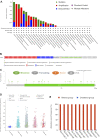Exercise-induced IL-15 acted as a positive prognostic implication and tumor-suppressed role in pan-cancer
- PMID: 36467072
- PMCID: PMC9712805
- DOI: 10.3389/fphar.2022.1053137
Exercise-induced IL-15 acted as a positive prognostic implication and tumor-suppressed role in pan-cancer
Abstract
Objective: Exercise can produce a large number of cytokines that may benefit cancer patients, including Interleukin 15 (IL-15). IL-15 is a cytokine that has multiple functions in regulating the adaptive and innate immune systems and tumorigenesis of lung and breast cancers. However, the roles of IL-15 in other types of cancer remain unknown. In this article, we try to systematically analyze if IL-15 is a potential molecular biomarker for predicting patient prognosis in pan-cancer and its connection with anti-cancer effects of exercise. Methods: The expression of IL-15 was detected by The Cancer Genome Atlas (TCGA) database, Human protein Atlas (HPA), and Genotype Tissue-Expression (GTEX) database. Analysis of IL-15 genomic alterations and protein expression in human organic tissues was analyzed by the cBioPortal database and HPA. The correlations between IL-15 expression and survival outcomes, clinical features, immune-associated cell infiltration, and ferroptosis/cuproptosis were analyzed using the TCGA, ESTIMATE algorithm, and TIMER databases. Gene Set Enrichment Analysis (GSEA) was performed to evaluate the biological functions of IL-15 in pan-cancer. Results: The differential analysis suggested that the level of IL-15 mRNA expression was significantly downregulated in 12 tumor types compared with normal tissues, which is similar to the protein expression in most cancer types. The high expression of IL-15 could predict the positive survival outcome of patients with LUAD (lung adenocarcinoma), COAD (colon adenocarcinoma), COADREAD (colon and rectum adenocarcinoma), ESCA (esophageal carcinoma), SKCM (skin cutaneous melanoma), UCS (uterine carcinosarcoma), and READ (rectum adenocarcinoma). Moreover, amplification was found to be the most frequent mutation type of IL-15 genomic. Furthermore, the expression of IL-15 was correlated to the infiltration levels of various immune-associated cells in pan-cancer assessed by the ESTIMATE algorithm and TIMER database. In addition, IL-15 is positively correlated with ferroptosis/cuproptosis-related genes (ACSL4 and LIPT1) in pan-cancer. Levels of IL-15 were reported to be elevated in humans for 10-120 min following an acute exercise. Therefore, we hypothesized that the better prognosis of pan-cancer patients with regular exercise may be achieved by regulating level of IL-15. Conclusion: Our results demonstrated that IL-15 is a potential molecular biomarker for predicting patient prognosis, immunoreaction, and ferroptosis/cuproptosis in pan-cancer and partly explained the anti-cancer effects of exercise.
Keywords: IL-15; exercise; ferroptosis/cuproptosis; immune; multi-analyses; pan-cancer; prognosis.
Copyright © 2022 Luo, He, Qin, Chen, Qi, Lin, Sun, Sun, Su, Long and Chen.
Conflict of interest statement
The authors declare that the research was conducted in the absence of any commercial or financial relationships that could be construed as a potential conflict of interest.
Figures








Similar articles
-
Identifies microtubule-binding protein CSPP1 as a novel cancer biomarker associated with ferroptosis and tumor microenvironment.Comput Struct Biotechnol J. 2022 Jun 24;20:3322-3335. doi: 10.1016/j.csbj.2022.06.046. eCollection 2022. Comput Struct Biotechnol J. 2022. PMID: 35832625 Free PMC article.
-
Identification of SHCBP1 as a potential biomarker involving diagnosis, prognosis, and tumor immune microenvironment across multiple cancers.Comput Struct Biotechnol J. 2022 Jun 18;20:3106-3119. doi: 10.1016/j.csbj.2022.06.039. eCollection 2022. Comput Struct Biotechnol J. 2022. PMID: 35782736 Free PMC article.
-
Prognostic Implication and Oncogenic Role of PNPO in Pan-Cancer.Front Cell Dev Biol. 2022 Jan 21;9:763674. doi: 10.3389/fcell.2021.763674. eCollection 2021. Front Cell Dev Biol. 2022. PMID: 35127701 Free PMC article.
-
Integrative data mining and meta-analysis to investigate the prognostic role of microRNA-200 family in various human malignant neoplasms: A consideration on heterogeneity.Gene. 2019 Oct 20;716:144025. doi: 10.1016/j.gene.2019.144025. Epub 2019 Aug 5. Gene. 2019. PMID: 31394177 Review.
-
The role of Cyclin Dependent Kinase Inhibitor 3 (CDKN3) in promoting human tumors: Literature review and pan-cancer analysis.Heliyon. 2024 Feb 8;10(4):e26061. doi: 10.1016/j.heliyon.2024.e26061. eCollection 2024 Feb 29. Heliyon. 2024. PMID: 38380029 Free PMC article. Review.
Cited by
-
Exploring the relationship between the interleukin family and lung adenocarcinoma through Mendelian randomization and RNA sequencing analysis.Discov Oncol. 2024 Sep 12;15(1):436. doi: 10.1007/s12672-024-01325-1. Discov Oncol. 2024. PMID: 39264458 Free PMC article.
-
Mechanisms of exercise in the treatment of lung cancer - a mini-review.Front Immunol. 2023 Aug 24;14:1244764. doi: 10.3389/fimmu.2023.1244764. eCollection 2023. Front Immunol. 2023. PMID: 37691942 Free PMC article. Review.
-
Decoding the tumor microenvironment and molecular mechanism: unraveling cervical cancer subpopulations and prognostic signatures through scRNA-Seq and bulk RNA-seq analyses.Front Immunol. 2024 Feb 28;15:1351287. doi: 10.3389/fimmu.2024.1351287. eCollection 2024. Front Immunol. 2024. PMID: 38482016 Free PMC article.
-
The role of myokines in cancer: crosstalk between skeletal muscle and tumor.BMB Rep. 2023 Jul;56(7):365-373. doi: 10.5483/BMBRep.2023-0064. BMB Rep. 2023. PMID: 37291054 Free PMC article. Review.
-
Carboplatin-resistance-related DNA damage repair prognostic gene signature and its association with immune infiltration in breast cancer.Front Immunol. 2025 Jan 29;16:1522149. doi: 10.3389/fimmu.2025.1522149. eCollection 2025. Front Immunol. 2025. PMID: 39944694 Free PMC article.
References
-
- Berger A., Colpitts S. J., Seabrook M. S. S., Furlonger C. L., Bendix M. B., Moreau J. M., et al. (2019). Interleukin-15 in cancer immunotherapy: IL-15 receptor complex versus soluble IL-15 in a cancer cell-delivered murine leukemia model. J. Immunother. Cancer 7, 355–413. 10.1186/s40425-019-0777-8 - DOI - PMC - PubMed
-
- Bohlen J., McLaughlin S. L., Hazard-Jenkins;Infante H. A. M., Montgomery C., Davis M., Pistilli E. E., et al. (2018). Dysregulation of metabolic-associated pathways in muscle of breast cancer patients: Preclinical evaluation of interleukin-15 targeting fatigue. J. Cachexia Sarcopenia Muscle 9, 701–714. 10.1002/jcsm.12294 - DOI - PMC - PubMed
LinkOut - more resources
Full Text Sources

